Research group unearths new info on photo-ageing damage

The joint study on skin ageing was carried out by the Innovative Beauty Science Laboratory of Kanebo Cosmetics, in collaboration with the Departments of Dermatology, Plastic Surgery, and Cell Biology of Tokai University School of Medicine and established a method of evaluation based on "photo-ageing histological stage".
With this study, Kanebo hopes to promote development of products that effectively protect against UVA and counteract photo-ageing.
The research group developed an index to show gradual changes in tissues, for the purpose of investigating the relationship between the effect of UV irradiation on skin and changes in dermal tissue.
Degree of degeneration
After a simultaneous evaluation of the dermal components elastin, collagen, and decorin, the researchers were able to classify the degree of degeneration of the dermis extracellular matrix into 6 stages.
That evaluation system was termed 'photo-ageing histological stage' and used to establish an index for the progress of dermal tissue changes caused by photo-ageing.
In photo-aged skin, it was visually confirmed for the first time that elastin deteriorates in the lower dermis during the early stage.
“UVA radiation is considered to play a significant role in the development of photo-ageing, thus our findings again showed that protection against both UVB and UVA is important to maintain beautiful skin,” say the researchers.
To investigate the relationship between photo-ageing histological stage and skin appearance, the skin of 26 female subjects was analysed.
Wrinkles
A correlation was found between photo-ageing histological stage and wrinkle score, which revealed that the scores for wrinkles in the corners of the eyes, and clarity and depth of wrinkles were higher in skin in an advanced stage; confirming that deterioration of collagen, elastin, and decorin is significantly involved in the formation of wrinkles.
To clarify the mechanism of skin photo-ageing, the research group searched for factors greatly affected by UV irradiation in human skin.
Those results revealed the importance of COMP (cartilage oligomeric matrix protein), a kind of protein that stimulates collagen formation, in photo-aged skin.
Based on these findings, Kanebo considers it likely that COMP can be utilized as a marker to determine photo-aging damage accelerated by UVA.






![Able C&C has furthered its partnership with Japanese discount chain Daiso with new makeup launch. [A'pieu]](/var/wrbm_gb_food_pharma/storage/images/_aliases/wrbm_tiny/publications/cosmetics/cosmeticsdesign-asia.com/headlines/brand-innovation/a-pieu-and-daiso-launch-exclusive-2-makeup-line/17339117-1-eng-GB/A-pieu-and-Daiso-launch-exclusive-2-makeup-line.jpg)
![Down Under Enterprises is setting sights on the Asian market as environmental sustainability and traceability become increasingly important. [Getty Images]](/var/wrbm_gb_food_pharma/storage/images/_aliases/wrbm_tiny/publications/cosmetics/cosmeticsdesign-asia.com/headlines/market-trends/down-under-enterprises-shifts-focus-to-china-as-environmental-sustainability-traceability-come-into-the-spotlight/17304932-1-eng-GB/Down-Under-Enterprises-shifts-focus-to-China-as-environmental-sustainability-traceability-come-into-the-spotlight.jpg)
![News updates from Shiseido, Dr.Ci:Labo, Sephora, and more. [Shiseido]](/var/wrbm_gb_food_pharma/storage/images/_aliases/wrbm_tiny/publications/cosmetics/cosmeticsdesign-asia.com/headlines/brand-innovation/updates-from-shiseido-dr.ci-labo-sephora-and-more/17334944-1-eng-GB/Updates-from-Shiseido-Dr.Ci-Labo-Sephora-and-more.jpg)

![Clariant has underscored the importance of localisation strategies and distribution capabilities in China with beauty trends evolving at a rapid pace. [Getty Images]](/var/wrbm_gb_food_pharma/storage/images/_aliases/wrbm_tiny/publications/cosmetics/cosmeticsdesign-asia.com/article/2024/04/16/clariant-emphasises-importance-of-localisation-in-the-era-of-viral-trends/17327969-1-eng-GB/Clariant-emphasises-importance-of-localisation-in-the-era-of-viral-trends.jpg)

![We dive into our most-read stories on formulation and science. [Getty Images]](/var/wrbm_gb_food_pharma/storage/images/_aliases/wrbm_tiny/publications/cosmetics/cosmeticsdesign-asia.com/headlines/formulation-science/skin-science-latest-stories-on-cosmetics-science-and-formulation/17334719-1-eng-GB/Skin-science-Latest-stories-on-cosmetics-science-and-formulation.jpg)


